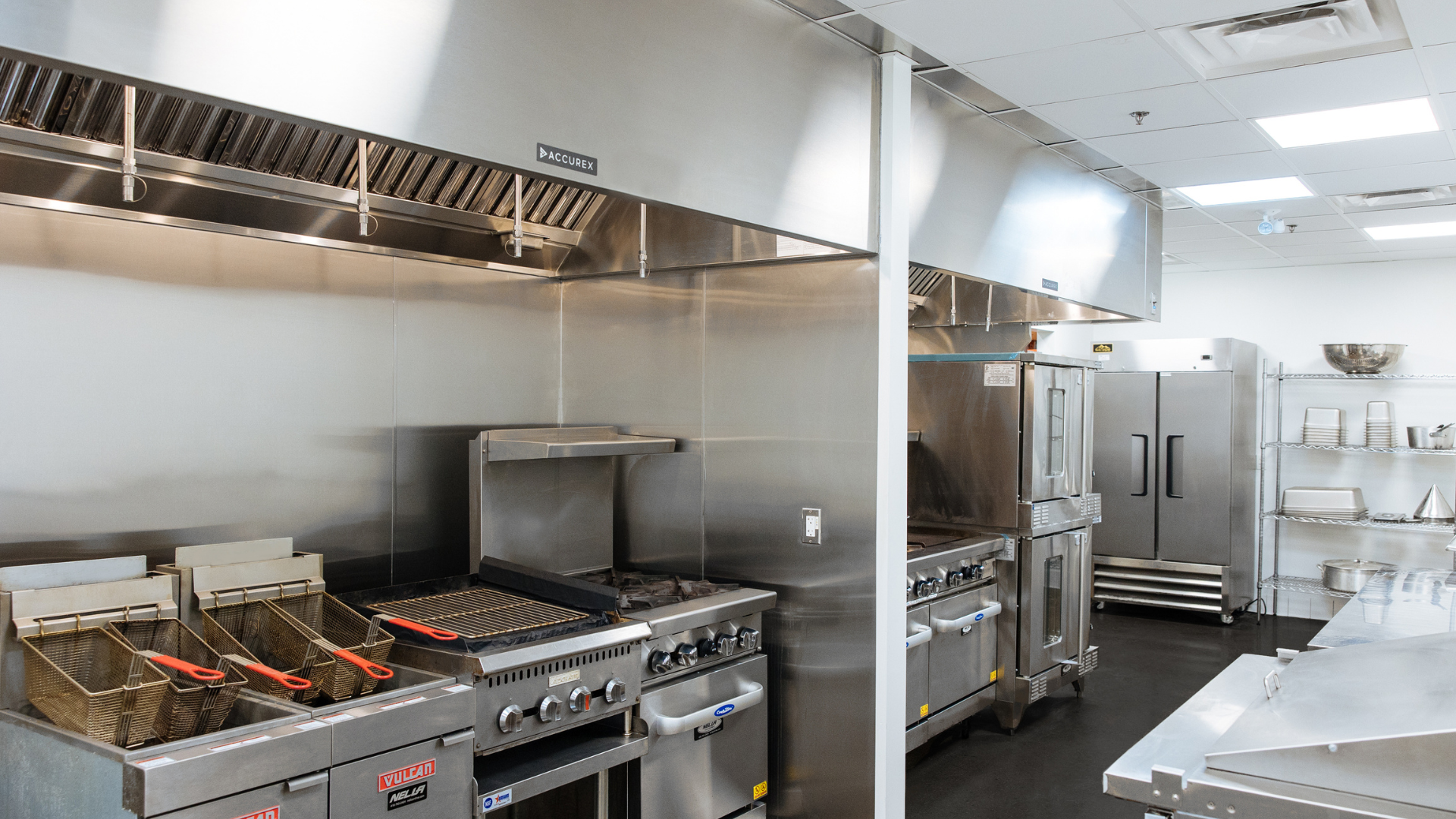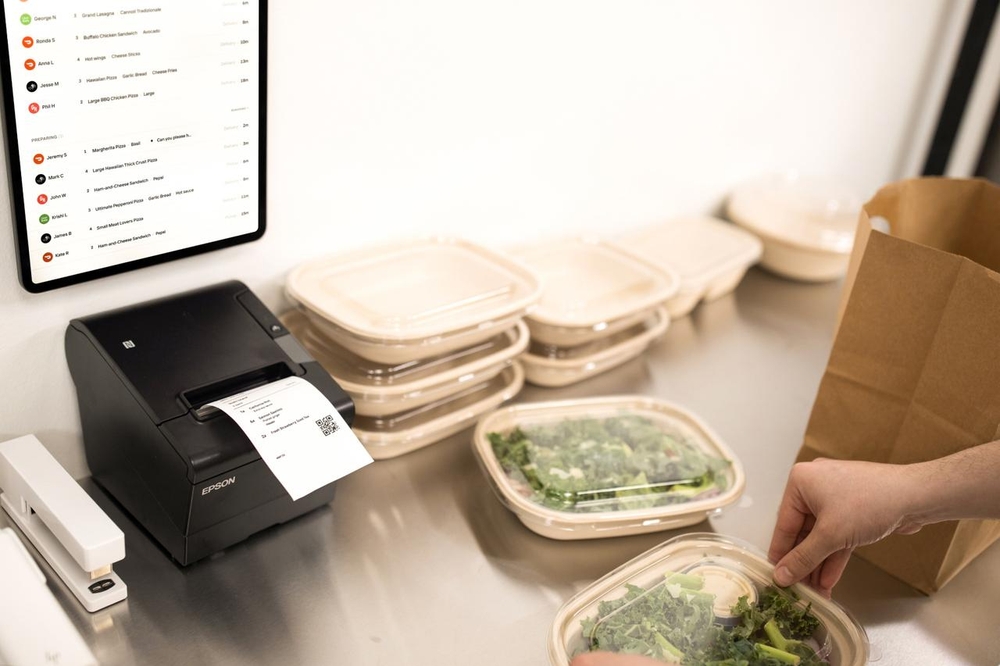What is a Commercial Kitchen?
Table of Contents
CloudKitchens
How many tacos can be delivered from a 1000sqft restaurant?
The same amount as a 200sqft ghost kitchen.

Commercial kitchens power restaurants, delivery services, and catering companies the world over. They’re designed to facilitate the quick (and delicious) production of food for sale to hungry customers.
Rather than pay concern to aesthetics, commercial kitchens focus on making meal preparation and delivery easier. They’re also often available for rent at reasonable prices.
What is a commercial kitchen, exactly, and how can you use one to advance your culinary operations? This flavor-balanced guide hits all the notes to explain what they have, their advantages, and how to use them to grow your food business.
What is a Commercial Kitchen?
Commercial kitchens are designed to meet the needs of businesses and organizations handling large volumes of food. We’re talking industrial-scale food production, not your home kitchen.
These kitchens must be equipped with commercial-grade refrigerators, exhaust systems, and fire suppression systems. They’re also meticulously planned to maximize space utilization and efficiency during food prep.
Beyond that, commercial kitchens must adhere to very strict safety and hygiene standards, as they’re used for large-scale food production for public consumption. This includes robust fire suppression, clearly marked emergency exits, and stringent sanitation protocols.
In essence, commercial kitchens are built for high-volume, business-oriented use, focusing on production efficiency and safety. This means they’re exceptionally well-equipped, expertly designed, and packed with safety features for staff, along with ample food storage resources.
What’s inside a commercial kitchen?
When you first step into a commercial kitchen, you may notice some keen differences from their residential counterparts. Wooden cabinets, stone countertops, and purely ornamental decor likely won’t be found within.
Instead, every surface, equipment, and storage space is designed to catalyze culinary creation. Commercial kitchens, compared to their smaller-scale residential counterparts, lend to cooking for the masses and fulfilling delivery orders at high volume. While a commercial kitchen’s specific equipment varies from place to place, generally, commercial kitchens contain:
- Conveyor or commercial-grade ovens
- One or more commercial ranges
- Ample counter space to prepare, chop, and arrange your mise en place
- Stainless steel refrigerators and freezers
- Exhaust hoods
- Hand-washing and dish-washing stations
- Commercial-grade fryers
- Dishwashers that can support high volumes of dishes
- Microwaves or food warming equipment
- Grills or grill tops
Some commercial kitchens may offer the use of smaller, more niche pieces of equipment such as blenders, food processors, or stand mixers. On the other hand, keep in mind that not all commercial kitchens will supply appliances, but they’ll provide all the necessary space and hook-ups to equip your cooking space once you’re ready to set up shop.
Example of a Commercial Kitchen
A typical example of a commercial kitchen is a fully equipped, shared space that food businesses can rent to prepare meals at a larger scale. These kitchens come with all the necessary appliances, including commercial-grade ovens, stovetops, refrigeration units, and prep stations, allowing chefs to efficiently produce food for restaurants, catering services, or delivery.
By sharing the space with other food businesses, the costs of maintaining a private kitchen are significantly reduced. Each business operates independently but benefits from access to high-quality equipment and infrastructure designed to handle high-volume cooking. This setup is particularly advantageous for food entrepreneurs, catering companies, and small restaurants aiming to scale their operations while keeping overhead costs low.
How Much Does it Cost to Rent a Commercial Kitchen in the Best Cities?
Renting a commercial kitchen can vary significantly depending on location and amenities. Here are some average rental costs in top U.S. cities:
- New York City: $35 to $50 per hour
- Los Angeles: $25 to $40 per hour
- Chicago: $20 to $35 per hour
- San Francisco: $30 to $45 per hour
- Miami: $20 to $30 per hour
- Dallas: $15 to $25 per hour
- Denver: $18 to $30 per hour
Factors like kitchen size, equipment availability, and location within the city can influence the price. Kitchens in prime, high-traffic areas or those offering premium equipment may come at a higher cost. Conversely, shared kitchen spaces, like ghost kitchens, are more affordable and offer flexible terms, making them attractive to emerging food businesses looking to save on overhead costs.
What’s the Difference Between a Commercial Kitchen and a Regular Kitchen?
Commercial kitchens must meet strict health codes and regulations set by local governments—a stark contrast to personal home kitchens. Plus, anyone preparing food in a commercial setting (employees) needs food safety certifications to ensure consumer health.
Another key differentiator is size. Commercial kitchens need to be larger, not just to accommodate staff, but also to house industrial-scale equipment, which is typically bigger than what you’d find in a normal home kitchen.
Finally, there are the essential safety mechanisms, like fire detectors and suppression systems, that every commercial kitchen must have.
All these requirements lead to one last major difference: commercial kitchens are considerably more expensive than regular kitchens, with costs potentially reaching up to $250,000 to meet all these rigorous standards.
How are commercial kitchens designed?
Countless commercial kitchens are operating behind the scenes of restaurants and other culinary entities in every corner of the globe. While many are similar, they don’t all follow the same design. Regardless, there are some common principles that make expediting food preparation safe and simple in commercial kitchens, including:
- Maintaining a logical flow to the kitchen with items processed in a single direction
- Creating distinct zones to avoid cross-contamination between foods and chemicals, such as separating meats from vegetables and separating cleaning products from food
- Stainless steel counters, equipment, and cookware to keep food surfaces clean
Commercial kitchens also leave room for customizations to accommodate a range of production styles. For example, a pizza kitchen may have more ample preparation space next to multiple ovens, while a burger joint may want to forgo ovens altogether to install a large flattop.
Nevertheless, regardless of the type of cuisine, there are two commonly used flow patterns for work in commercial kitchens. In general, a space’s layout should facilitate either:
- American line: In American lines, a plate moves from chef to chef as each team member contributes their component of the dish.
- European line: In European lines, each team member prepares their specialty component separately before compiling them together at the end.
Deciding on your work pattern, along with other preferences, can help you design your ideal commercial kitchen. If you’re hunting for an existing space rather than building your own custom kitchen from the ground up, keep these tips in mind as you search.
How do you choose a commercial kitchen?
When deciding on a commercial kitchen for your food service business, consider how well it will serve your goals. Think about factors such as:
- The equipment required to prepare your dishes
- Expenses and how well a commercial kitchen fits your budget
- The amount of space you need to work with your crew
- The location of the commercial kitchen in relation to your target market
- How you’re going to get the food to your customers
Importantly, your kitchen must also conform to the overall concept you have for your business. If you want to open up a traditional, dine-in eatery, your commercial kitchen will need to be attached to a dining space with the capacity to house the number of customers you intend to be able to service each day.
But, if you’re considering focusing solely on delivery with a small crew of workers, a ghost kitchen may be a better option. Ghost kitchens are essentially shared commercial kitchen spaces that can be rented on flexible terms and for minimal hours—a savvy option for food entrepreneurs who want to open quickly at a lower price.

What are the advantages of a ghost kitchen?
If a ghost kitchen doesn’t appeal to you yet, consider this: the projection of food delivery services is only set to increase. Ordering in is becoming so popular, in fact, that the National Restaurant Association projects the industry to reach nearly $1 trillion by the end of 2023.
Ghost restaurants take advantage of consumers’ love of convenience by eliminating dining rooms and wait for staff to focus on turning out meals for home delivery. They offer a plethora of advantages over conventional eateries, including:
- Reduced rent and more flexible leasing terms
- Decreased startup costs with the elimination of building permits
- A lower monthly payroll with fewer staff to hire
- Smaller utility bills in a more compact space
- Less money spent on branding and advertising for a dine-in space
- The ability to start up quickly and expand into new regions
- The freedom to focus on preparing quality food, rather than dine-in customers
Ghost kitchens may also fit a restaurateur’s personal situation better than traditional restaurants. Since they focus on delivery only, ghost kitchens don’t need to reside in areas with heavy foot traffic—meaning restaurateurs can set up shop wherever is convenient for them.
Ghost kitchens also allow experimenting or aspiring chefs to test-run new ideas without committing thousands of dollars to a brand-new restaurant. Simply rent a ghost kitchen for a few months to test-run the viability of an area, market, demographic, or menu concept.
Indeed, ghost kitchens are a secure, quick, and relatively inexpensive way to kick-start your success on the food delivery scene anywhere in the US—and the ones from CloudKitchens are a cut above the rest.
Start your delivery restaurant in a ghost kitchen from CloudKitchens
Many key aspects of CloudKitchens make them similar to commercial kitchens. Most crucially, they’re designed to get chefs cooking fast and delivering faster.
At CloudKitchens, it’s our goal to get your culinary creations in front of more hungry customers. With our ghost kitchens, you can reach a larger audience in weeks, not months.
Then, when you’re all set up and ready for your first deliveries, you can manage your entire operations from one single device. Just head to our app to access every order, integrate your desired delivery platforms, and use the data analytics to make smart decisions about your growing business.
CloudKitchens helps restaurateurs turn their ideas into reality sooner by providing the space, systems, and support needed to get your food on the market immediately. With CloudKitchens, you can go from concept to cooking in as little as six weeks—we can even help you acquire the few permits you’ll need to work in one of our spaces.
Book a tour of one of CloudKitchen’s ghost kitchens to see all the advantages that they offer over traditional commercial kitchens.
Explore ghost kitchen locations across the US:
- Ghost kitchens in San Francisco
- Ghost kitchens in LA
- Ghost kitchens in NYC
- Ghost Kitchens in Toronto
- Ghost Kitchens in Atlanta
- Ghost Kitchens in Dallas
- Ghost Kitchens in Chicago
- Ghost Kitchens in Denver
- Ghost Kitchens in Miami
| DISCLAIMER: This information is provided for general informational purposes only and the content does not constitute an endorsement. CloudKitchens does not warrant the accuracy or completeness of any information, text, images/graphics, links, or other content contained within the blog content. We recommend that you consult with financial, legal, and business professionals for advice specific to your situation. |
Read more:
- Essential Guide to Industrial Kitchen Equipment for Ghost Kitchens
- How much does it cost to rent a Commercial Kitchen?
- Top 5 commercial kitchen layout ideas to maximize efficiency
- How to grow & improve your catering sales
Sources:
Los Angeles County Department of Public Health. Shared Kitchen Complex. http://www.publichealth.lacounty.gov/
University of Minnesota. Commercial Kitchen Guide. https://conservancy.umn.edu/
Boston University. Kitchen Organization in Full-Service Restaurants: Reducing Heat and Stress. https://www.bu.edu/
CloudKitchens. Commercial kitchens built for delivery. https://cloudkitchens.com/
Fox Business. Food and alcohol delivery and takeout will remain mainstays in 2023: report. https://www.foxbusiness.com/
More insights & stories
There’s more where that came from.
Get in the know and check out our additional insights


